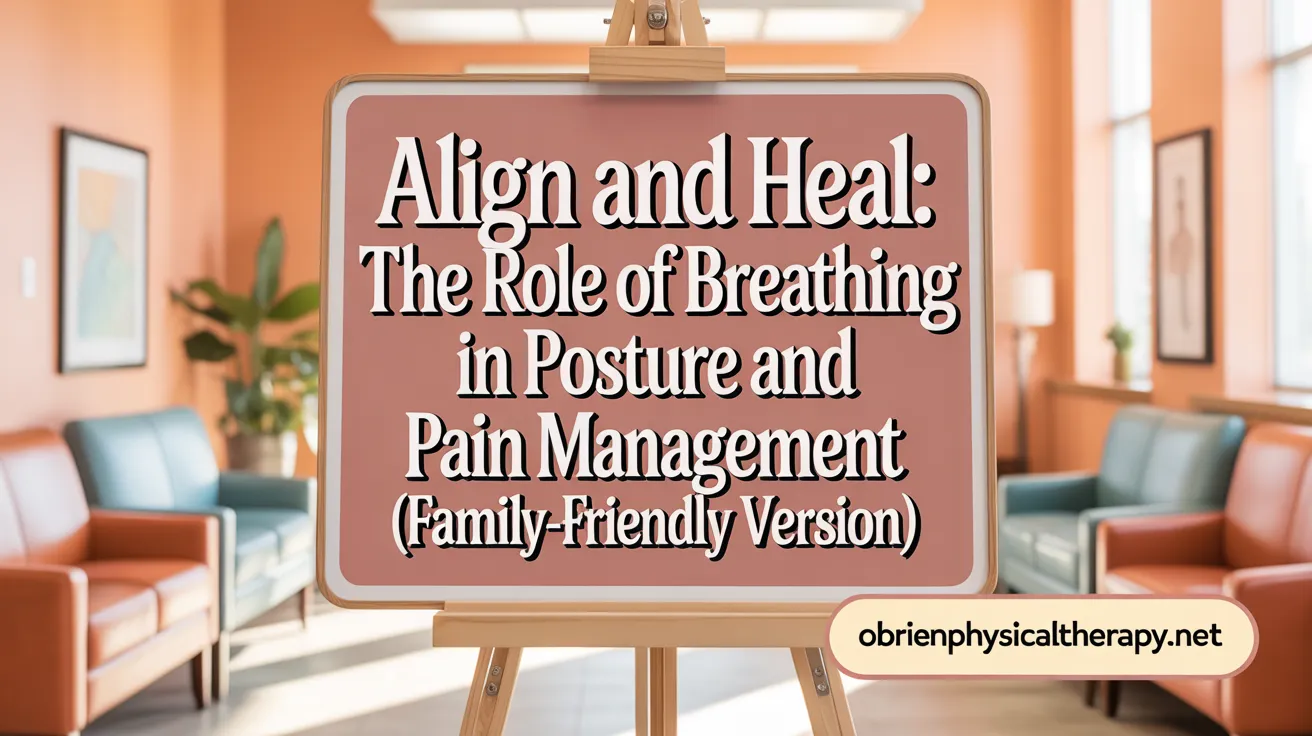Understanding the Power of Breath in Pain Management
Breathing is a vital, involuntary process, but emerging research reveals its profound influence over our experience of pain. This article explores how specific breathing techniques, especially slow deep breathing and diaphragmatic breathing, serve as powerful tools in pain relief. We delve into the physiological and neurological mechanisms behind breathing’s analgesic effects, review evidence-based benefits, and provide practical guidance on implementing these techniques. By embracing mindful control of breath, individuals can tap into a natural, non-invasive method to manage acute and chronic pain while fostering relaxation and overall health.
The Relationship Between Breathing Techniques and Pain Relief
 How breathing techniques influence pain perception
How breathing techniques influence pain perception
Breathing techniques, especially slow, deep breathing exercises, have been shown to impact how we perceive pain. These practices promote full diaphragmatic inhalations and controlled exhalations, which activate the body’s relaxation response. Such activation helps to reduce muscle tension, calm the nervous system, and alter the emotional response to pain. For example, techniques like 4-7-8 breathing or box breathing can help shift the body from stress and fight-or-flight mode to a state of calm, reducing the sensation of pain.
Role of the vagus nerve and relaxation pathways
A crucial element in the connection between breathing and pain relief is the vagus nerve. This nerve plays a major role in mediating the parasympathetic nervous system, responsible for relaxing the body after stress. Deep diaphragmatic breathing stimulates the vagus nerve, triggering what is called the relaxation or 'rest and digest' response. When activated, this response can lower heart rate, blood pressure, and stress hormone levels like cortisol, all of which contribute to an increased sense of calm and reduced pain sensations.
Summary of meta-analysis findings on slow deep breathing (SDB) and pain
A comprehensive review and meta-analysis of seven randomized controlled trials found that slow deep breathing significantly reduced pain scores in adults experiencing acute pain. Particularly striking was the effect on burn pain, with a standardized mean difference (SMD) of -2.24, indicating a strong pain reduction compared to usual care. However, results varied among studies, suggesting heterogeneity that warrants further high-quality research. It’s worth noting that no significant effects were observed in the contexts of obstetric labor or postoperative pain, indicating that the benefits of SDB may be condition-specific.
Pain conditions with notable breathing-related relief
Certain types of pain, like burn injuries, appear to respond very well to slow breathing exercises. The substantial reduction in burn pain highlights the potential of SDB as a supportive therapy in acute severe pain scenarios. Additionally, research involving low back pain shows that breathing exercises can improve clinical outcomes, decrease pain scores, and support spinal stability. While findings are promising, effects on labor or postoperative pain are less consistent, emphasizing that breathing techniques might be more effective in some pain conditions than others.
Psychological and physiological factors influenced by controlled breathing
Controlled breathing impacts both psychological and physiological domains. It helps reduce anxiety, stress, and depression by calming the nervous system. Physiologically, deep breathing can lower heart rate, blood pressure, and cortisol levels, which are all linked to pain modulation. Moreover, regular practice fosters better oxygenation, muscle relaxation, and emotional regulation, contributing to a more comprehensive approach to pain management. Although the physiological mechanisms are not yet fully understood, current evidence underscores that breathing exercises can serve as a natural, side-effect-free means to enhance pain relief and overall wellbeing.
Scientific and Physiological Mechanisms Underlying Breathing and Pain Management
Breathing plays a significant role in modulating pain through complex physiological and neural pathways. These include the activation of the parasympathetic nervous system, primarily via effective engagement of the vagus nerve during slow, deep breathing exercises. This activation triggers the body’s relaxation response, leading to reduced muscle tension, decreased cortisol levels, and improved blood flow, all of which contribute to pain relief.
Neural circuits involved in this process respond to noxious stimuli by increasing breathing rates and adjusting emotional responses. For instance, specific neurons such as PBL_Oprm1_ are known to react to painful stimuli by elevating respiration and influencing pain perception, linking respiratory activity to emotional and behavioral pain responses.
Controlled breathing techniques like diaphragmatic or paced deep breathing enhance heart rate variability and stimulate the vagus nerve. These actions help lower inflammation and anxiety, which are often associated with pain. Moreover, breathing influences pain signals through the gate control theory, where sensory input from respiration can inhibit nociceptive signals from reaching the brain, thus dampening the perception of pain.
While substantial evidence supports the role of these mechanisms in pain management, ongoing research aims to clarify the specific physiological pathways involved. Overall, breathing not only provides a calming physical response but also activates neural circuits that diminish pain processing, making it a vital tool in non-pharmacological pain management strategies.
Evidence Supporting Diaphragmatic Breathing for Chronic Pain Relief
Research into diaphragmatic breathing highlights its positive effects on managing chronic pain conditions. Multiple clinical studies have demonstrated that engaging in slow, deep breathing activates the parasympathetic nervous system, which calms the body's stress response and reduces levels of cortisol, a stress hormone linked to pain and inflammation.
This breathing technique promotes relaxation, resulting in lowered blood pressure and heart rate, and enhances oxygen intake throughout the body. Such physiological changes contribute to a reduction in pain perception, especially in conditions like low back pain and respiratory disorders.
Moreover, diaphragmatic breathing strengthens respiratory muscles and improves core stability. Improved trunk support not only alleviates back pain but also enhances overall posture and spinal health.
Systematic reviews and randomized controlled trials examining breathing exercises underscore their role in pain reduction and quality of life improvements. For example, studies specifically focused on low back pain reveal significant decreases in pain scores and disability indices after consistent practice.
In summary, diaphragmatic breathing supports pain management through stress modulation, promoting muscle relaxation, and improving physiological functions. Such evidence advocates its integration into comprehensive pain therapy programs, offering a safe, accessible, and effective adjunct for individuals suffering from chronic pain.
Implementing Effective Breathing Techniques for Pain Management
Overview of diaphragmatic and paced breathing methods
Breathing techniques such as diaphragmatic breathing, also called belly breathing, and paced breathing are commonly used to help manage pain. Diaphragmatic breathing involves deep, slow inhalations that engage the diaphragm, strengthening it and promoting relaxation. Paced breathing includes controlled patterns like 4-7-8 breathing and box breathing, which involve regulating the length of inhales, exhales, and pauses. These methods activate the body's relaxation response, reduce stress hormones, and improve oxygen flow, all of which can diminish pain perception.
Mindful Breathing’s Role in Managing Low Back Pain

How mindful breathing increases body awareness
Mindful breathing enhances a person's awareness of their body by focusing attention on the breath, awareness of muscle tension, and posture. This heightened body awareness helps individuals recognize early signs of muscle tension and maladaptive postures that can contribute to low back pain. Techniques such as diaphragmatic or belly breathing encourage gentle awareness of abdominal movement, improving proprioception and encouraging healthier movement patterns.
Synergistic effects with core stability exercises
When combined with core stability exercises, mindful breathing can lead to superior pain relief and functional improvements. This synergy occurs because both practices target different aspects of pain management: breathing techniques promote relaxation and reduce tension, while core exercises strengthen the muscles supporting the spine. Studies have shown that this combined approach results in lower pain scores, greater improvements in mobility, and enhanced overall quality of life.
Evidence from randomized controlled trials
Multiple RCTs have demonstrated the effectiveness of mindful breathing in reducing low back pain. For example, participants practicing mindful breathing alongside physiotherapy experienced a significant decrease in pain levels, evidenced by lower scores on the Visual Analogue Scale (VAS). One such study reported that the VAS pain scores decreased by approximately 2.7 points, underscoring the therapeutic benefits of integrating breathing exercises into standard care.
Reduction in Visual Analogue Scale (VAS) pain scores
The VAS is a widely used method to quantify pain intensity. Research indicates that mindful breathing can greatly lower VAS scores, often by more than 2 points, indicating substantial pain reduction. This decrease not only diminishes discomfort but also improves patients' capacity to perform daily activities, ultimately promoting independence and well-being.
Potential to reduce medication reliance and improve quality of life
Practicing mindful breathing techniques can lessen the need for pharmacological pain management, reducing medication-related side effects. Furthermore, by decreasing stress and improving mental focus, these practices help elevate overall quality of life. Patients report better sleep, reduced anxiety, and improved mood, all of which contribute to more effective pain management and enhanced daily functioning.
| Aspect | Findings | Additional Details |
|---|---|---|
| Body Awareness | Increases recognition of tension | Helps prevent muscle overuse and poor posture |
| Combined Therapies | Synergy with core exercises | Leads to greater pain relief and mobility |
| Evidence Level | Supported by multiple RCTs | Demonstrates significant reductions in pain scores |
| Pain Measurement | Decrease in VAS scores | Approximate reduction of 2.7 points observed |
| Broader Impact | Reduced medication reliance | Enhances overall life quality and mental health |
Relaxation and Holistic Health Benefits of Breathing Practices for Pain Relief
 Breathing exercises, especially diaphragmatic or slow deep breathing, play a crucial role in promoting relaxation and enhancing overall health, which can significantly aid in pain relief. These practices activate the parasympathetic nervous system, often called the body’s rest-and-digest system, which counters the stress response driven by the sympathetic nervous system.
Breathing exercises, especially diaphragmatic or slow deep breathing, play a crucial role in promoting relaxation and enhancing overall health, which can significantly aid in pain relief. These practices activate the parasympathetic nervous system, often called the body’s rest-and-digest system, which counters the stress response driven by the sympathetic nervous system.
A key component of this relaxation pathway involves stimulation of the vagus nerve, which helps decrease heart rate and stabilize blood pressure. As a result, physical tension reduces, and the body enters a calmer state, making pain more manageable.
One of the physiological benefits is the improved oxygenation of tissues. Deep breathing facilitates better oxygen exchange in the lungs, leading to increased oxygen supply to vital organs and muscles. This reduces muscle tension and helps the body relax more efficiently.
In addition to physical effects, breathing practices can lower levels of cortisol, a hormone associated with stress. Reduced cortisol levels help decrease feelings of anxiety and depression, fostering better emotional regulation. This emotional well-being is vital, as stress and negative emotions often amplify pain perception.
Furthermore, engaging in regular breathing exercises can improve sleep quality by encouraging relaxation and reducing nighttime stress. Better sleep supports recovery and overall health, which are important in managing chronic and acute pain.
Overall, controlled breathing techniques help the body shift into a state of calm, decreasing physiological stress signals, improving oxygen use, and boosting emotional resilience. These holistic effects make breathing exercises a valuable complement to pain management strategies, facilitating a more relaxed body and mind, and ultimately supporting pain relief.
The Interplay of Breathing, Posture, and Pain Reduction

Connection between breathing mechanics and skeletal posture
Proper breathing mechanics are essential for maintaining optimal skeletal alignment, especially in the spine and neck. When breathing is inefficient, often due to mouth breathing or shallow chest breathing, it can lead to postural issues such as forward head posture and shoulder winging. These structural changes can increase muscle tension and strain, contributing to musculoskeletal pain.
Role of the diaphragm in spinal stability
The diaphragm, the main muscle responsible for breathing, also acts as a postural stabilizer. When used effectively, diaphragmatic breathing engages deep core muscles, supporting the spine and reducing undue stress. Exercising this muscle through specific breathing techniques helps improve postural control and spinal stability, which can alleviate chronic back and neck pain.
Impacts of poor breathing patterns on musculoskeletal pain
Poor breathing habits, like mouth breathing or rapid shallow breaths, can cause imbalances in muscle tension across the upper body. This often results in increased tension in neck, shoulder, and back muscles, heightening the risk of pain and discomfort. Additionally, such patterns can impair oxygen delivery, negatively affecting muscle repair and stress response.
Positional breathing exercises for posture and pain relief
Positional exercises such as the breathing bridge and wall angels promote better posture and enhance respiratory mechanics. These movements encourage proper diaphragm engagement and strengthen postural stabilizers, helping to reduce pain caused by faulty breathing and poor posture. Regular practice improves mobility and aligns the skeleton correctly.
Nasal breathing and nitric oxide benefits for oxygenation
Breathing through the nose naturally releases nitric oxide, a molecule that increases oxygen absorption and improves overall breathing efficiency. Enhanced oxygenation supports tissue repair, reduces inflammation, and promotes relaxation, all of which contribute to pain reduction. Nasal breathing also encourages longer, calmer exhalations that activate the parasympathetic nervous system, aiding in stress and pain management.
| Topic | Effect/Benefit | Additional Notes |
|---|---|---|
| Breathing mechanics | Supports skeletal posture and reduces tension | Proper technique prevents postural deformities |
| Diaphragm function | Enhances spinal stability and core strength | Used in exercises like diaphragmatic breathing |
| Poor breathing patterns | Contribute to musculoskeletal pain and tension | Often linked to structural postural issues |
| Positional breathing exercises | Improve posture and alleviate pain | Includes techniques like wall angels and breathing bridge |
| Nasal breathing | Increases nitric oxide, boosting oxygenation and relaxation | Enhances overall respiratory efficiency |
Optimizing breathing techniques, especially through diaphragmatic and nasal breathing, can significantly impact musculoskeletal health. They not only promote better posture but also facilitate pain relief and stress reduction, creating a beneficial cycle for overall wellbeing.
Innovations and Emerging Research in Breathing-Based Pain Therapies
 Recent advancements highlight the promising role of respiratory muscle training devices like Inspiratory Muscle Strength Training (IMST) and Resperate in managing pain and lowering blood pressure. Studies show that IMST can significantly decrease systolic blood pressure by about 9 mm Hg after six weeks, emphasizing its cardiovascular benefits.
Recent advancements highlight the promising role of respiratory muscle training devices like Inspiratory Muscle Strength Training (IMST) and Resperate in managing pain and lowering blood pressure. Studies show that IMST can significantly decrease systolic blood pressure by about 9 mm Hg after six weeks, emphasizing its cardiovascular benefits.
Emerging evidence suggests that controlled breathing exercises influence cardiovascular function by slowing heart rate and stabilizing blood pressure, which can indirectly reduce pain sensations. These effects are thought to be mediated through the activation of the vagus nerve, which promotes the body's relaxation response.
Neurobiological pathways also play a crucial role in how breathing techniques impact pain and emotional processing. Breathing exercises activate brain regions involved in emotion regulation and pain perception, such as the limbic system, and stimulate endogenous pain-relief systems like the endogenous opioid pathway. This neurobiological activation helps explain the calming and pain-reducing benefits observed with practices like diaphragmatic and paced breathing.
Despite encouraging findings, current research faces limitations. Many studies exhibit methodological variability and heterogeneity, underscoring the need for higher quality, standardized research protocols. Clearer evidence would help establish best practices for integrating breathing techniques into pain management.
Looking ahead, the potential of breathing therapies in holistic, integrative approaches to pain care is substantial. Their ability to modulate physiological, neurological, and emotional pathways offers a promising avenue for non-pharmacological pain relief. Continued research and innovation could transform breathing exercises into a cornerstone of comprehensive pain management strategies.
Harnessing Breath for Effective Pain Management
Breathing techniques represent a promising, accessible approach to pain relief by engaging complex physiological and neurological systems that regulate stress, inflammation, and pain perception. From slow deep breathing to diaphragmatic and mindful breathing, these methods activate the body's relaxation response, reduce muscle tension, and improve oxygenation, which collectively help alleviate both acute and chronic pain. Clinical evidence confirms their benefits, particularly for conditions like burn pain and low back pain, while ongoing research continues to illuminate their underlying mechanisms. Incorporating breathing exercises into pain management regimens offers individuals a valuable, non-pharmacological tool to regain control over their pain and enhance overall wellbeing. With proper instruction and consistent practice, breathing techniques can empower patients and healthcare providers alike to embrace holistic strategies in the journey toward pain relief and improved quality of life.
References
- Effects of Slow Deep Breathing on Acute Clinical Pain in ...
- Pain and respiration: a systematic review
- Diaphragmatic Breathing
- Breathing Techniques for Pain Management
- It's not just inspiration – careful breathing can help your ...
- Best Breathing Techniques for Relaxation and Pain Relief
- Effects of breathing exercises on low back pain in clinical
- Diaphragmatic-Breathing-Assist-Self-Management-Pain. ...
- Diaphragmatic Breathing and Chronic Pain
